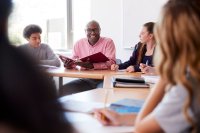3 Ways School Counselors Can Boost SEL
Tips for student support professionals working to promote social and emotional learning at a middle or high school.
Your content has been saved!
Go to My Saved Content.What is the role of student support professionals in fostering social and emotional learning (SEL) at the middle and high school levels? School counselors, psychologists, social workers, and other SSPs have many responsibilities, to which promoting SEL is typically an add-on. And we know that the context for SEL interventions in middle and high school is often one of time constraint.
Teachers need not be the only ones responsible for implementing SEL. We must remain realistic as to what they are able to accomplish during class time. Whether with individual students, groups, or entire classrooms, adequate time for comprehensive skill building is generally lacking. This may lead to attempts to get too much done too quickly, thereby sending students back to class without sufficient depth of learning. The effect of this is to cast a shadow on SEL interventions and those who implement them.
Taking Action
Fortunately, there are schools that have found vital roles that are accessible for many SSPs within their busy schedules. Here are three key ways counselors, school psychologists, and other student support professionals can promote and strengthen SEL at the middle or high school where they work.
1. Be part of a leadership team. By virtue of skills in child and adolescent development and leading groups, SSPs can take leadership roles on any SEL-related committees. These might be focused on character building, or overall school culture and climate, or anti-bullying. For example, counselors, the school social worker, and the school psychologist might consult or serve to guide trauma-sensitive training for teachers and staff.
Perhaps a committee has been formed to bring service learning to all age groups at a school. A school psychologist or counselor would be well-equipped to speak on the emotional and social developmental stages of the varied age groups so as to best match the types of service learning with specific grade levels.
2. Develop SEL-related understanding in adults. In many schools, staff may have only a cursory familiarity with SEL and related topics, yet start implementation regardless. We know that deep understanding of SEL on the part of staff is linked to higher sustainability.
Short publications for nontechnical readers and SEL videos can be good introductions, but for sustainability, deeper trainings and supports are needed. SSPs can play an important role in the design of a realistic plan to bring groups of individuals along in their SEL understanding.
3. Focus on strength development. Instead of an anger or stress management group for youth having difficulties, SSPs can assist in facilitating a leadership preparation group for these students. Framing the group as something that can make a positive contribution to the school will engender more cooperation and allow you to acknowledge strengths, as well as shortcomings, in response to questions like, “What qualities does a good leader have?” and “What makes for a trustworthy leader?”
The student leadership group may then move into action, responding to an environmental issue or carrying out a school improvement project, for example.
SSPs can contribute to guiding students in further developing the skills they already possess while also fostering news skills. This reframes skill building away from remediation and deficit. A key element found to be essential in SEL interventions is helping students set goals directed toward a positive purpose.
Sequence and Scope
Time is always a factor in working with students in secondary schools. The following developmental sequence of skill building should be used as a guide to focus SEL supports and interventions feasibly and effectively. Broadly speaking, the developmental sequence is:
- Self-awareness and self-management (with purpose being included as part of self-awareness and being one’s best self, followed by emotional competencies and self-control)
- Social awareness and relationship skills (including empathy, communication skills, and knowing one’s trigger situations)
- Responsible decision making and problem solving (which also includes anticipating and overcoming obstacles)
SEL interventions and programs that follow this sequence are associated with a range of positive outcomes, including improved student behavior, attendance, and academic performance, and reductions in punitive or exclusionary discipline.
Whether you are a school psychologist, counselor, or other student support professional, and whatever ways you decide to further contribute to SEL on your campus, create and share your plans with other school staff so they know the content of what you’re working on and how to best support it.
